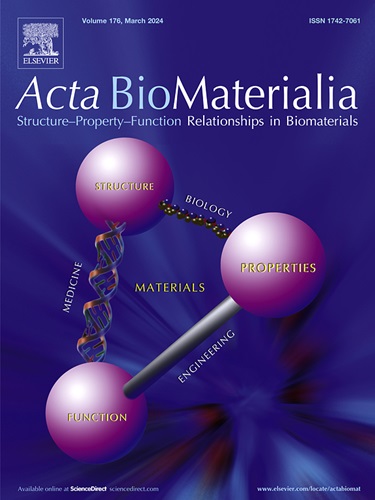Wet adhesives for hard tissues
IF 9.4
1区 医学
Q1 ENGINEERING, BIOMEDICAL
引用次数: 0
Abstract
The development of wet adhesives capable of bonding in aqueous environments, particularly for hard tissues such as bone, tooth, and cartilage, remains a significant challenge in material chemistry and biomedical research. Currently available hard tissue adhesives in clinical practice lack well-defined wet adhesion properties. Nature offers valuable inspiration through the adhesive mechanisms of marine organisms, advancing the design of bioinspired wet adhesives. Beyond biomimetic approaches, alternative strategies have emerged for the design of wet adhesives. This review systematically summarizes the current design strategies for wet adhesives, focusing on their applications to hard tissues. Then, the unique chemical, physical, mechanical, and biological requirements for wet adhesives applied to hard tissues are also discussed. The importance of understanding natural adhesion mechanisms and the need for high-performance materials that can meet the complex demands of hard tissue adhesion in a complex and delicate physiological microenvironment are highlighted. Finally, this review clarifies the future research directions that can further facilitate the clinical application of wet adhesives for hard tissues.
Statement of significance
The significance of this review lies in its comprehensive analysis of wet adhesives for hard tissues, a field that has been largely overlooked despite its critical importance in biomedical applications. The insights gained from studying natural adhesives and the translation of these mechanisms into synthetic materials have the potential to revolutionize medical procedures involving hard tissue repair and regeneration. This review meticulously addresses the distinct challenges and specific requirements of hard tissue adhesives, providing an exhaustive roadmap for researchers striving to develop wet adhesives that can endure the demanding physiological conditions inside the human body. In doing so, it aims to facilitate the transition from laboratory findings to practical clinical applications.

求助全文
约1分钟内获得全文
求助全文
来源期刊

Acta Biomaterialia
工程技术-材料科学:生物材料
CiteScore
16.80
自引率
3.10%
发文量
776
审稿时长
30 days
期刊介绍:
Acta Biomaterialia is a monthly peer-reviewed scientific journal published by Elsevier. The journal was established in January 2005. The editor-in-chief is W.R. Wagner (University of Pittsburgh). The journal covers research in biomaterials science, including the interrelationship of biomaterial structure and function from macroscale to nanoscale. Topical coverage includes biomedical and biocompatible materials.
 求助内容:
求助内容: 应助结果提醒方式:
应助结果提醒方式:


